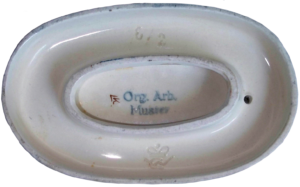 When you have an interest in any area of complex activity or information, it is important to understand the nomenclature of that topic. You may not understand certain words that you will run across from time to time when researching M.I. Hummel figurines but you will definitely appreciate more about this subject after reading some of these terms.
When you have an interest in any area of complex activity or information, it is important to understand the nomenclature of that topic. You may not understand certain words that you will run across from time to time when researching M.I. Hummel figurines but you will definitely appreciate more about this subject after reading some of these terms.
Updated 2 August 2022.
Arbeitsmuster – noun, arbeit (work), muster (sample). Literally, in German, a working sample from which to use as the primary example set before the painter or sculptor the way to paint or put together a figurine or other item. Many of the samples will also have a silvery metal tag attached with a wire to the figurine. See the photo for a similar tag below. This very old example is from an early Crown figurine HUM 6 – Sensitive Hunter and shows the earlier “Org. Arb. Muster” phrase stamped in blue.
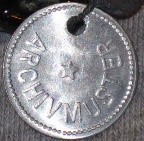 Archivmuster – noun, archiv (record), muster (sample). This would be a rare example that the company might wish to reserve in their archives for future historical reference as to what was created at a specific time period. These items will typically have attached, in a permanent fashion with a metal wire, a metal tag indicating this is a very special Hummel.
Archivmuster – noun, archiv (record), muster (sample). This would be a rare example that the company might wish to reserve in their archives for future historical reference as to what was created at a specific time period. These items will typically have attached, in a permanent fashion with a metal wire, a metal tag indicating this is a very special Hummel.
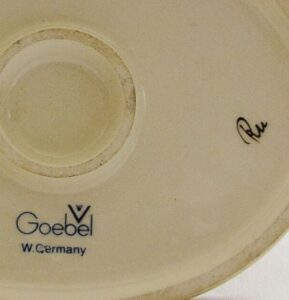 Artist’s mark – This the assigned initials of the face painter found on the bottom of the base in small hand-scripted black ink. Sometimes, the penned initials may also be found including the last two numbers of the year of the painting. The details of the face are very important to provide the innocent expression so well known with all M.I. Hummel figurines.
Artist’s mark – This the assigned initials of the face painter found on the bottom of the base in small hand-scripted black ink. Sometimes, the penned initials may also be found including the last two numbers of the year of the painting. The details of the face are very important to provide the innocent expression so well known with all M.I. Hummel figurines.
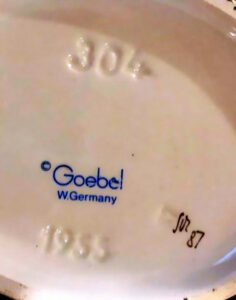 Assemblers number – A small incised production control number, usually two digits, to identify the person who assembled the individual soft clay parts of the figurine. Notice the mold number of HUM 304 – The Artist, the blue TMK-6 trademark, the copyright year of 1955, the artist’s signature in black ink, and the barely visible incised number 87 of the assembler to the left of the artist signature.
Assemblers number – A small incised production control number, usually two digits, to identify the person who assembled the individual soft clay parts of the figurine. Notice the mold number of HUM 304 – The Artist, the blue TMK-6 trademark, the copyright year of 1955, the artist’s signature in black ink, and the barely visible incised number 87 of the assembler to the left of the artist signature.
Backstamp – Also known as the trademark which designates the legal mark the factory places on the bottom of all of the M.I. Hummel items.
Bas relief – This is a sculptural relief in which the projection from the surrounding surface is only slightly done. This may be found on plaques, annual and anniversary plates.
 Big Bee – This trademark was used from the year 2000 through 2009 and added a large bumblebee to the previous trademark removing the small crown. This trademark was also known as the TMK-8.
Big Bee – This trademark was used from the year 2000 through 2009 and added a large bumblebee to the previous trademark removing the small crown. This trademark was also known as the TMK-8.
Bisque – Ceramic pieces which have been hard fired but not glazed yet.
Chalkware – These are typically also known as the Herbert Dubler Hummel figurines. Though they may be called “fake” Hummels, they were in fact produced during World War II when world conditions were such that Goebel was unable to protect their rights and although not sanctioned by the Siessen Convent, they are patterned after the original Hummels.
Closed Edition (CE) – A Hummel that will no longer be put into production either due to the trademark becoming outdated or the figurine will no longer be produced.
Closed Number (CN) – The assigned number in the system used to identify a design or sample model for possible production but was never authorized for release.
Club Year – The M.I. Hummel Club year begins on June 1st and ends on May 31st of each year. Your membership year dates from the time within these dates as the year you joined.
 Copyright Date (CRD) – A relatively large incised four-letter year in the bottom of the base that represents when the figurine design was registered with the United States Copyright Office but may not properly represent when general production began. The incised date may predate several years before the item was produced or painted but is a quick guide for which version of the figurine you are looking at. The year represented here is the incised 1955.
Copyright Date (CRD) – A relatively large incised four-letter year in the bottom of the base that represents when the figurine design was registered with the United States Copyright Office but may not properly represent when general production began. The incised date may predate several years before the item was produced or painted but is a quick guide for which version of the figurine you are looking at. The year represented here is the incised 1955.
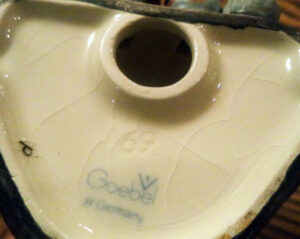 Crazing – Minor cracks in the glaze caused overage due to heat and moisture differences. Although the appearance is affected, minor crazing does not change the value very much. If the crazing is prominent from a distance, then the scared appearance can influence the desirability.
Crazing – Minor cracks in the glaze caused overage due to heat and moisture differences. Although the appearance is affected, minor crazing does not change the value very much. If the crazing is prominent from a distance, then the scared appearance can influence the desirability.
 Crown – The earliest trademark typically located on the bottom of the base in either an incised marking or a stamped version. This shows the item was made between the years of 1934 to 1950. This trademark is also known as the TMK-1. You may see an indication of this in the German word Kronenmarke which means Crown Mark.
Crown – The earliest trademark typically located on the bottom of the base in either an incised marking or a stamped version. This shows the item was made between the years of 1934 to 1950. This trademark is also known as the TMK-1. You may see an indication of this in the German word Kronenmarke which means Crown Mark.
Decimal Point – Earlier figurines would periodically be found with a decimal point after the mold number. It is speculated that this might have been to help determine whether the number, as an example, was a 66 or a 99.
Double Crown – The Crown mark is found as both an incised as well as a stamped version on the same item. These are highly soug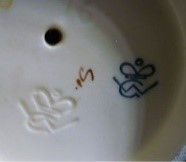 ht out and command a representative price as well.
ht out and command a representative price as well.
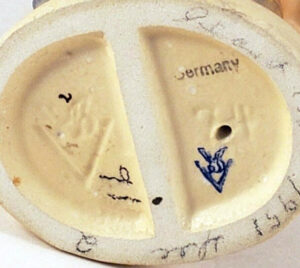 Double Full Bee – Describes the factory trademark found on some M.I. Hummel figurines with the Full Bee TMK-2 mark as having both incised and stamped trademarks on the underside of a figurine.
Double Full Bee – Describes the factory trademark found on some M.I. Hummel figurines with the Full Bee TMK-2 mark as having both incised and stamped trademarks on the underside of a figurine.
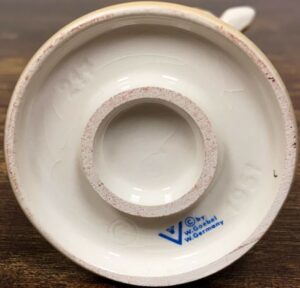 Doughnut base – This is the raised circular support on the underside of the figurine as shown here.
Doughnut base – This is the raised circular support on the underside of the figurine as shown here.
Exclusive Edition (EE) – Figurines reserved for only M.I. Hummel Club membership not to be released to the general public and includes a special Club backstamp to indicate this.
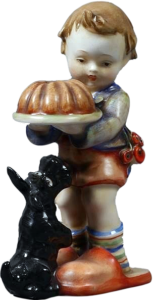 Faience – noun, (pronounced fay-ontz) A finishing method of colorization that provided a bright color and high gloss. This was one of the original experimental techniques used by the Goebel production line for M.I. Hummel Figurines in the early 1940s and but it was abandoned in favor of the traditional appearance of the Hummel figurines. After an initial firing, they were dipped in a liquid tin glaze and then used lead and cadmium-based paints which didn’t cure evenly and were therefore not used in production models. Some Hummel collectors of the rarest Hummels consider the Faiences as the greatest part of their collections due to their scarcity and brilliant coloration. The word is derived from the French for the porzellana di Faenza, fine tin-glazed and painted earthenware made in Faenza, Italy.
Faience – noun, (pronounced fay-ontz) A finishing method of colorization that provided a bright color and high gloss. This was one of the original experimental techniques used by the Goebel production line for M.I. Hummel Figurines in the early 1940s and but it was abandoned in favor of the traditional appearance of the Hummel figurines. After an initial firing, they were dipped in a liquid tin glaze and then used lead and cadmium-based paints which didn’t cure evenly and were therefore not used in production models. Some Hummel collectors of the rarest Hummels consider the Faiences as the greatest part of their collections due to their scarcity and brilliant coloration. The word is derived from the French for the porzellana di Faenza, fine tin-glazed and painted earthenware made in Faenza, Italy.
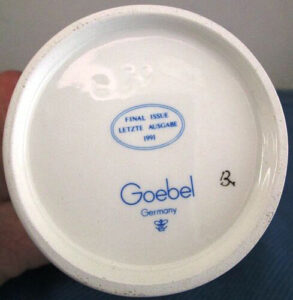 Final Issue – This will be a figurine that has been declared to be permanently retired from production and will not be produced again. These typically carry a backstamp decal on the bottom of the base to indicate this with the year of the final issue of each figurine created in that year only.
Final Issue – This will be a figurine that has been declared to be permanently retired from production and will not be produced again. These typically carry a backstamp decal on the bottom of the base to indicate this with the year of the final issue of each figurine created in that year only.
 First Issue – Beginning in 1990, this is a term used by the factory to indicate all newly released figurines during their first year of production. The figurine will typically have a blue decal on the bottom of the base to indicate the year of the first issue during that year and then the following years will no longer include the decal.
First Issue – Beginning in 1990, this is a term used by the factory to indicate all newly released figurines during their first year of production. The figurine will typically have a blue decal on the bottom of the base to indicate the year of the first issue during that year and then the following years will no longer include the decal.
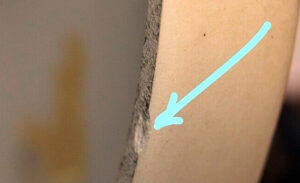 Flea Bite – A term used to indicate a very small imperfection, whether a flake of paint missing or a very small chip in the figurine. This is typically not something noticeable upon initial inspection but is a defect and may contribute to lessening the value of the item.
Flea Bite – A term used to indicate a very small imperfection, whether a flake of paint missing or a very small chip in the figurine. This is typically not something noticeable upon initial inspection but is a defect and may contribute to lessening the value of the item.
 Full Bee – The trademark found on the bottom of the base with a large bumblebee within the letter V which stands for the German name for a distribution company, “Verkaufsgesellschat”. This trademark was used between 1950 and 1957 overlapping the earlier Crown trademark. Early usage of this trademark can be found as an incised variation of the mark with later versions represented by a stamp. This trademark is also known as the TMK-2.
Full Bee – The trademark found on the bottom of the base with a large bumblebee within the letter V which stands for the German name for a distribution company, “Verkaufsgesellschat”. This trademark was used between 1950 and 1957 overlapping the earlier Crown trademark. Early usage of this trademark can be found as an incised variation of the mark with later versions represented by a stamp. This trademark is also known as the TMK-2.
Goebelit – A special earthenware developed by the Goebel Company where the low firing temperature allows for the many bright colors used.
 Handmade – The current trademark is TMK-11 and was introduced in December 2017 placing a smaller bumblebee to the right of the word Hummel with the word Handmade placed at the top and the phrase Germany est. 1935 below.
Handmade – The current trademark is TMK-11 and was introduced in December 2017 placing a smaller bumblebee to the right of the word Hummel with the word Handmade placed at the top and the phrase Germany est. 1935 below.
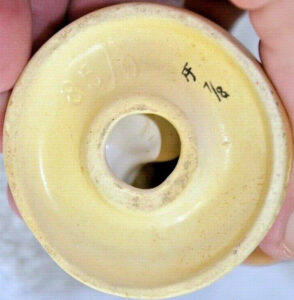 Hollow Mold – Describes a figurine that is open on the underside of the base allowing for a clear view into the cavity of the figurine. This allows for the gases to escape when being fired and precludes the necessity of punching a small hole in an obscure place.
Hollow Mold – Describes a figurine that is open on the underside of the base allowing for a clear view into the cavity of the figurine. This allows for the gases to escape when being fired and precludes the necessity of punching a small hole in an obscure place.
 HUM Number – This is the mold number or model number incised on the bottom of each M.I. Hummel figurine at the factory and is used for identification purposes. The HUM number in this image, as shown, is #304.
HUM Number – This is the mold number or model number incised on the bottom of each M.I. Hummel figurine at the factory and is used for identification purposes. The HUM number in this image, as shown, is #304.
 International – There are very few of these Hummel figurines and were all created in 1940 by Master Sculptors Arthur Möller and Reinhold Unger as samples for consideration in representing many different countries in the native country clothing. They were not accepted by the Sießen Convent so were not put into production. There are as few as only one and as many as five of each of the approximately 28 samples made. These have commanded a very high price in the past when they were up for auction. There has been some speculation that these were given to certain dignitaries of the countries represented during the beginning of World War II.
International – There are very few of these Hummel figurines and were all created in 1940 by Master Sculptors Arthur Möller and Reinhold Unger as samples for consideration in representing many different countries in the native country clothing. They were not accepted by the Sießen Convent so were not put into production. There are as few as only one and as many as five of each of the approximately 28 samples made. These have commanded a very high price in the past when they were up for auction. There has been some speculation that these were given to certain dignitaries of the countries represented during the beginning of World War II.
 Last Bee – This trademark was used from 1972 through 1979 and used the Goebel name above W. Germany along with the stylized bee inside the letter V above the letters b and e. A later version included the copyright symbol. It is also known as the TMK-5.
Last Bee – This trademark was used from 1972 through 1979 and used the Goebel name above W. Germany along with the stylized bee inside the letter V above the letters b and e. A later version included the copyright symbol. It is also known as the TMK-5.
Limited Edition – A figurine or other Hummel item that is produced for a specific time period or in a limited quantity.
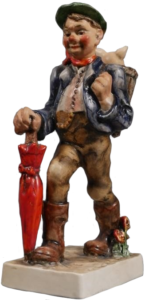 Mamas and Papas – These 4 samples were made by master sculptor Arthur Möeller and were not approved by the Sießen Convent for production. They were each listed as a Closed Number on 18 February 1948 and will not be produced again. It was not considered typical of Sister M.I. Hummel’s work although they are an exact replica of one of her early sketches. Mr. Miller valued each at between $15,000 and $20,000 in 2003.
Mamas and Papas – These 4 samples were made by master sculptor Arthur Möeller and were not approved by the Sießen Convent for production. They were each listed as a Closed Number on 18 February 1948 and will not be produced again. It was not considered typical of Sister M.I. Hummel’s work although they are an exact replica of one of her early sketches. Mr. Miller valued each at between $15,000 and $20,000 in 2003.
 Manufaktur – This trademark was used after the Yellow Bee mark until December 2017. It shows a much larger yellow bee to the left of the word Hummel and is also known as TMK-10.
Manufaktur – This trademark was used after the Yellow Bee mark until December 2017. It shows a much larger yellow bee to the left of the word Hummel and is also known as TMK-10.
Masterpiece – An adjective typically attached to a very special Hummel that is considered “perfect”, much like the Archivmuster. A masterpiece is designated by the factory as such and rarely available for purchase.
Masterpiece Series Collection – These eleven M.I. Hummel figurines are recent additions and are much larger than the typical five-inch versions. The mold number will also reflect this with the Roman numeral suffix III as well. They may be seen at HummelGifts.com.
Meisterwerk – meister (master), werk (work). A masterpiece as recognized by the company masters as a “perfect” piece. A highly prized piece to own.
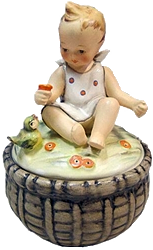 MEL – These few Hummel figurines are classified as the “MELs” since they have those last three letters of Hummel inscribed on the base and are found to be early samples typically between 1939 and 1940 with three a few years later. Some of these were presented to the Sisters at the Convent for their consideration or they may also be test examples to see how they looked after creating them from the sketches.
MEL – These few Hummel figurines are classified as the “MELs” since they have those last three letters of Hummel inscribed on the base and are found to be early samples typically between 1939 and 1940 with three a few years later. Some of these were presented to the Sisters at the Convent for their consideration or they may also be test examples to see how they looked after creating them from the sketches.
 Missing Bee – This trademark was used from 1979 through 1991 and appeared as the Last Bee version but with the bee within the letter V missing, thus the name. A registered mark was also added to the right of the name Goebel. This was known as the TMK-6 trademark.
Missing Bee – This trademark was used from 1979 through 1991 and appeared as the Last Bee version but with the bee within the letter V missing, thus the name. A registered mark was also added to the right of the name Goebel. This was known as the TMK-6 trademark.
Mold Growth – Earlier figurine production used a softer plaster of paris material for the molds. As they were used, the molded parts became larger with repeated use. Newer technology practices now use acrylic resin molds eliminating this size difference between a given size designation.
Mold Induction Date (MID) – The year incised in the base of the figurine to indicate the year of copyright.
 Mother Mold – The initial mold from which the prototype is created. The mother mold is used for producing working molds by casting them with special earthenware material.
Mother Mold – The initial mold from which the prototype is created. The mother mold is used for producing working molds by casting them with special earthenware material.
Mother Mold Samples – The first cast of a decorated figurine.
Muster – noun. This word is used in conjunction with others to explain patterns, samples, or models.
Mustermaler – noun, muster (pattern), maler (painter or artist). This will apply to a painter’s sample so that the painter of the figurine or other item is duplicated in the same way.
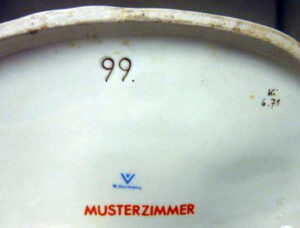 Musterzimmer – noun, muster (model), zimmer (room). You may find a rare example with this on the base and it implies that it is a perfect example to be publicly displayed as an ideal showroom sample to be used for future reference by production artists. ” After the decision to mass produce was made painted samples by the master painters were produced. The factory executives (not the Convent) then decided upon the one master painted sample upon which the painters would reference their paintings. This master painted sample was referred to as Muster Zimmer in German or Originalmuster. Sometimes the Term Orig Azbt Muster was placed on the base. In addition, the red circle was applied (if the base so allowed it). Also, some master samples had an accompanying metal tag with the term Arbeitsmuster and the factory location (Oeslau & Rodental after 1971). Oeslau and surrounding villages were incorporated as Rodental in 1971. Some figurines have a accompanying red circle and the factory duplicate labeled it as a Master sample with the letter M for Muster Zimmer.” According to Wolfgang Seidl, “MUSTERZIMMER was a special room by the good old GOEBEL company, in this room the company aloud only dealers or special groups from the USA to see what all is done in the past. BUT it is no longer exist.”.
Musterzimmer – noun, muster (model), zimmer (room). You may find a rare example with this on the base and it implies that it is a perfect example to be publicly displayed as an ideal showroom sample to be used for future reference by production artists. ” After the decision to mass produce was made painted samples by the master painters were produced. The factory executives (not the Convent) then decided upon the one master painted sample upon which the painters would reference their paintings. This master painted sample was referred to as Muster Zimmer in German or Originalmuster. Sometimes the Term Orig Azbt Muster was placed on the base. In addition, the red circle was applied (if the base so allowed it). Also, some master samples had an accompanying metal tag with the term Arbeitsmuster and the factory location (Oeslau & Rodental after 1971). Oeslau and surrounding villages were incorporated as Rodental in 1971. Some figurines have a accompanying red circle and the factory duplicate labeled it as a Master sample with the letter M for Muster Zimmer.” According to Wolfgang Seidl, “MUSTERZIMMER was a special room by the good old GOEBEL company, in this room the company aloud only dealers or special groups from the USA to see what all is done in the past. BUT it is no longer exist.”.
Open Edition (OE) – This is available to the general public bearing the factory backstamp only.
Open Number (ON) – A mold number that has not been assigned to any figurine.
Org. Artz. Muster – Literally translates to “Original artist sample” found on some of the earlier Crown figurines. Most of these are found with a stamp of this phrase but very few have this inscribed.
Out of Production – Factory term used to designate items that are not in production but may later be determined as closed edition, remain temporarily withdrawn, or returned to current production status.
Oversize – Refers to a piece that has experienced “mold growth” in its size expansion. This applies mostly to earlier production pieces before the mold material was changed to reduce this.
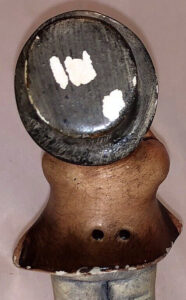 Paint Flake – A flaw on a figurine where the paint has chipped off but the glazed surface remains intact. Notice on this figurine the loss of paint on the top of the hat as well as along the edge of the bottom of the jacket. The older figurines have more prominent occurrences of paint flakes and the recent change in the process of painting and glazing has dramatically reduced this likelihood.
Paint Flake – A flaw on a figurine where the paint has chipped off but the glazed surface remains intact. Notice on this figurine the loss of paint on the top of the hat as well as along the edge of the bottom of the jacket. The older figurines have more prominent occurrences of paint flakes and the recent change in the process of painting and glazing has dramatically reduced this likelihood.
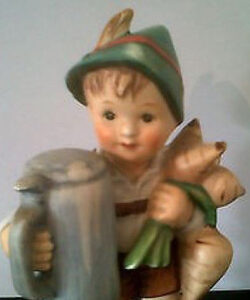 Paint Rub – A general wearing away of a painted surface in an excessive handling of a figurine or use of abrasive cleaners which may show up on a tip of the hair or the end of an umbrella. In the photograph to the right, it appears there is a gradual loss of paint on the front tip of the green hat as well as the nose.
Paint Rub – A general wearing away of a painted surface in an excessive handling of a figurine or use of abrasive cleaners which may show up on a tip of the hair or the end of an umbrella. In the photograph to the right, it appears there is a gradual loss of paint on the front tip of the green hat as well as the nose.
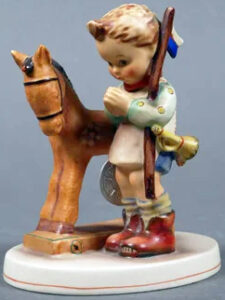 Painter’s Sample – This is a figurine used by the painters at the factory that serves as a reference figurine for the painting of subsequent pieces. The painters attempt to paint their individual pieces to match the painter’s sample as precisely as possible. Many times, these have a red ring around the base (see also Red Line). Notice also the metal tag affixed to the figurine with a metal wire.
Painter’s Sample – This is a figurine used by the painters at the factory that serves as a reference figurine for the painting of subsequent pieces. The painters attempt to paint their individual pieces to match the painter’s sample as precisely as possible. Many times, these have a red ring around the base (see also Red Line). Notice also the metal tag affixed to the figurine with a metal wire.
Porcelain – Although the Goebel company was known for the products they created in porcelain, it was determined that the unique character of Maria Innocentia Hummel’s art would be better reproduced in the warmer feel of the earthenware that Goebel had developed in the mid 1920s. Some of the earlier pieces were experimental in the use of porcelain and may be found on rare occasion. An example of this can be seen with the early version of HUM 105 – Adoration with Bird.
Possible Future Edition (PFE) – These are Hummels that are to be considered for future production but have not been released publicly. Some, in the past, have taken quite a number of years from their inception before being produced for the public.
Preview Edition – These are figurines with an exclusive M.I. Hummel Club backstamp offered to members for a special preview period.
Production Mould Sample – “Cast out of the first mould for later production.”
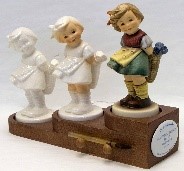 Progression Set – A collection of a number of the same figurine showing the individual processes of a figurine from the mold to the finished, glazed item typically placed on a customized wooden board for display.
Progression Set – A collection of a number of the same figurine showing the individual processes of a figurine from the mold to the finished, glazed item typically placed on a customized wooden board for display.
Prototype – This indicates the “one and only sample (first out of the mother mould) that is presented to the Convent of any newly developed M.I. Hummel figurine.” “In the early years of production (pre-computers) quality control was somewhat lacking. After Reinhold Unger or Arthur Moeller sculpted a figurine (based on Sister Maria’s drawings) the figurines (usually 4-6 samples) were painted and then fired in the kiln. The first one out was called a prototype by Goebel and presumably saved in the Archives. This was not necessarily the one taken to the Convent for approval. Logically, the best painted specimen would have been selected for approval. After approval Goebel executives then had to decide whether the figurine was economically viable &, if so, when to mass produce it. In the early years this was an easier decision. Later, with many more samples, the decision was harder and many wound up in the Archives as PFE’s with production delayed until a later date.”
Rattle – On occasion, when a hole is pierced in the initial stage of the soft earthenware to allow for the gases to escape during firing to keep the figurine from exploding, a piece of the material will be captured inside the figurine after firing causing a “rattle” when shaken. It may also be used as an identifier that might come in handy when comparing one figurine to another that is otherwise identical.
 Red Line – Also known as Red Rim. “The production samples are produced in a first test production which run out of the first working mould. For some time these first pre-produced working models have been marked, as described in your publication with a red rim. This red rim mark means that these figurines have been used as production samples.” This indicates that this certain figurine was used as a “perfect” model with the paint scheme to use on all others by the artists as the standard. This may also indicate the item to be considered as a Masterpiece by some serious collectors.
Red Line – Also known as Red Rim. “The production samples are produced in a first test production which run out of the first working mould. For some time these first pre-produced working models have been marked, as described in your publication with a red rim. This red rim mark means that these figurines have been used as production samples.” This indicates that this certain figurine was used as a “perfect” model with the paint scheme to use on all others by the artists as the standard. This may also indicate the item to be considered as a Masterpiece by some serious collectors.
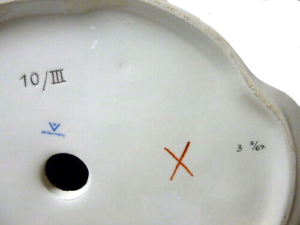 Red X – Many times, there is not a way to show a red line around a base and a Red X is used instead and may be found on the bottom of the base indicating the same specification. “The red X is nearly the same as an red line. Masterpieces have this sign on the base and normally on a plain base is the red line and when the figurine has a natural base, then the figurine show a red X from the master painter. The red line and the red X is a part of the details of a MASTERPAINTER figurine.”
Red X – Many times, there is not a way to show a red line around a base and a Red X is used instead and may be found on the bottom of the base indicating the same specification. “The red X is nearly the same as an red line. Masterpieces have this sign on the base and normally on a plain base is the red line and when the figurine has a natural base, then the figurine show a red X from the master painter. The red line and the red X is a part of the details of a MASTERPAINTER figurine.”
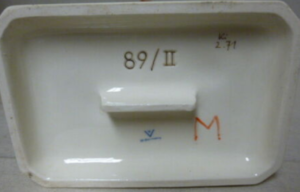 Red M – This was found on a HUM 89/III – Little Cellist Red Line figurine which had the line around the base but also had the letter M in red underneath the base. Still inquiring about this one. Some figurines have a accompanying red (line) circle and the factory duplicate labeled it as a Master sample with the letter M for Muster Zimmer.
Red M – This was found on a HUM 89/III – Little Cellist Red Line figurine which had the line around the base but also had the letter M in red underneath the base. Still inquiring about this one. Some figurines have a accompanying red (line) circle and the factory duplicate labeled it as a Master sample with the letter M for Muster Zimmer.
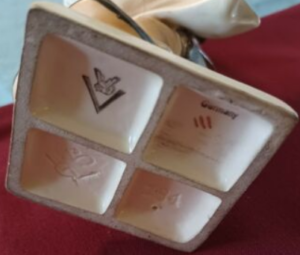 Red 3 Slashes – Typically found on figurines of the Crown TMK-1 and Full Bee TMK-2 era. Not sure at this time what this represents unless it is a certain master painter’s initials.
Red 3 Slashes – Typically found on figurines of the Crown TMK-1 and Full Bee TMK-2 era. Not sure at this time what this represents unless it is a certain master painter’s initials.
Reinstated – This is a figurine that has been placed back into production by the factory after some prior classification of non-production.
Retired – Term used to describe a figurine that has been permanently removed from production. The molds have been broken and the figurine will never be produced again.
Reversed Molds – this appears in several items in the Hummel line. Birthday Serenade is a good example where the figurine appeared originally with two children playing musical instruments, the boy playing the horn and the girl playing the accordion. Later editions reversed the instruments by request of the Convent and the boy is shown playing the accordion and the girl the horn. Demand for the older version has increased due to the few available.
Sample – A new M.I. Hummel or variation would be introduced to the governing board of the Sießen Convent for their consideration of whether this piece warranted acceptance to the strict parameters of how closely the sketches were represented. This item was considered to be a sample and may have been one of a kind in many instances. These were often considered trinkets in the earlier decades of the Hummels and handed out as gifts to the factory workers as a type of reward. The value of this would be well above the average value of similar production pieces.
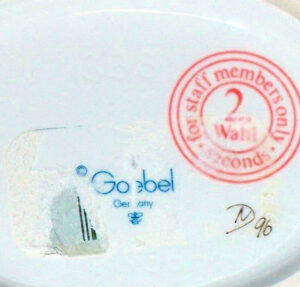 Slash Mark – An imperfection or flawed figurine found during the final inspection was marked by grinding a groove through the trademark. These were sold to the factory employees as seconds. Notice the slash groove through the Goebel trademark and the additional red “for staff members only seconds.”
Slash Mark – An imperfection or flawed figurine found during the final inspection was marked by grinding a groove through the trademark. These were sold to the factory employees as seconds. Notice the slash groove through the Goebel trademark and the additional red “for staff members only seconds.”
 Small Crown – The trademark located beneath the base was very similar to the preceding trademark but removed the letter W since Germany became unified and a small original Crown mark was added beneath the name Germany. This was used from 1991 through 2000 and was known as the TMK-7 trademark.
Small Crown – The trademark located beneath the base was very similar to the preceding trademark but removed the letter W since Germany became unified and a small original Crown mark was added beneath the name Germany. This was used from 1991 through 2000 and was known as the TMK-7 trademark.
Stepped Base – A few older figurines had a base that was “stepped” where there was a ridge around the full base that had an indention around the entire outside top. This was popular for a short time on some of the earlier HUM 7 – Merry Wanderer Full Bees.
 Stylized Bee – The trademark found on the bottom of the base changed the Full Bee to a more stylized bee which now was much smaller as a dot with two triangles raised above all within the letter V. This trademark was used from 1960 through 1972. This trademark is also known as the TMK-3.
Stylized Bee – The trademark found on the bottom of the base changed the Full Bee to a more stylized bee which now was much smaller as a dot with two triangles raised above all within the letter V. This trademark was used from 1960 through 1972. This trademark is also known as the TMK-3.
Temporarily Withdrawn (TW) – Assigned by the factory to indicate that a particular item is being withdrawn from production for some time, but may be reinstated at a future date.
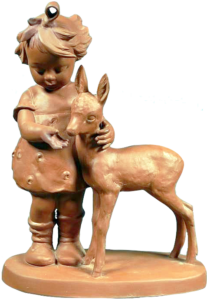 Terra Cotta – Italian for “baked earth”. A type of earthenware is a clay-based unglazed or glazed ceramic typically reddish-brown in color, where the fired body is porous and unpainted. This was used in an experimental fashion by the artisans at the W. Goebel Porzellanfabrik with very few figurines produced in this material. Examples in terra cotta were not deemed a suitable material for the figurines. Expect to find these at a higher value than most other materials.
Terra Cotta – Italian for “baked earth”. A type of earthenware is a clay-based unglazed or glazed ceramic typically reddish-brown in color, where the fired body is porous and unpainted. This was used in an experimental fashion by the artisans at the W. Goebel Porzellanfabrik with very few figurines produced in this material. Examples in terra cotta were not deemed a suitable material for the figurines. Expect to find these at a higher value than most other materials.
 Three Line Mark – This trademark incorporated the typical Stylized Bee trademark but added the words © by, W. Goebel, W. Germany to the right side in three lines. This trademark was used from 1964 until 1972 and is also known as the TMK-4.
Three Line Mark – This trademark incorporated the typical Stylized Bee trademark but added the words © by, W. Goebel, W. Germany to the right side in three lines. This trademark was used from 1964 until 1972 and is also known as the TMK-4.
 Transitional – This word is used to describe the inclusion of two different trademarks on the same item indicating a period of time when the Hummel piece was created and a different trademark period when the piece was painted. The most common occurrence of this is a combination of the Crown TMK-1 and Full Bee TMK-2 trademarks as shown here.
Transitional – This word is used to describe the inclusion of two different trademarks on the same item indicating a period of time when the Hummel piece was created and a different trademark period when the piece was painted. The most common occurrence of this is a combination of the Crown TMK-1 and Full Bee TMK-2 trademarks as shown here.
TM – (TMK) An abbreviation for the word trademark.
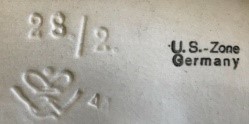 U.S. Zone – The words “U.S. ZONE – GERMANY” were used between 1946 and 1948, the stamped marking may have been applied to Crown TMK-1 trademarked figurines when the United States was active after World War II in Germany and is marked accordingly limited to the three years of occupation. This was during the time prior to the country being divided from the west and east. There is recorded at least one occurrence where a Full Bee TMK-2 figurine is stamped with the U.S. Zone Germany mark.
U.S. Zone – The words “U.S. ZONE – GERMANY” were used between 1946 and 1948, the stamped marking may have been applied to Crown TMK-1 trademarked figurines when the United States was active after World War II in Germany and is marked accordingly limited to the three years of occupation. This was during the time prior to the country being divided from the west and east. There is recorded at least one occurrence where a Full Bee TMK-2 figurine is stamped with the U.S. Zone Germany mark.
Underglaze – The trademark was added before the last process of applying a finished glaze to ensure the mark was permanent.
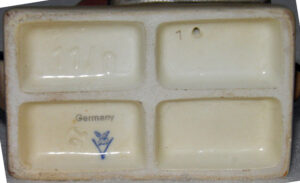 Waffle Base – A term used to describe the reinforced base with a quartered or divided addition.
Waffle Base – A term used to describe the reinforced base with a quartered or divided addition.
White Overglaze – An item that has not been painted but has been glazed and fired. The pieces are completely white. All figurines are produced in this finish before being painted.
 Yellow Bee – This trademark was dramatically changed in comparison to past marks. This trademark has a colorful bee in a circle with the words inside the circle “Original M. I. Hummel Germany” and then outside at the bottom was used beginning in 2009 and was known as TMK-9.
Yellow Bee – This trademark was dramatically changed in comparison to past marks. This trademark has a colorful bee in a circle with the words inside the circle “Original M. I. Hummel Germany” and then outside at the bottom was used beginning in 2009 and was known as TMK-9.
Zusatzstempel – noun, Zusatz (addition), stempel (stamp). An additional stamp may even be the black stamped “Germany” or “U.S. Zone”.
References
Antique Marks. (2021) Hummel Marks & Markings. Retrieved on 21 April 2021 from https://antique-marks.com/hummel-marks.html
Arbenz, P. (1976-1978). Hummel Facts. Pat’s Columns Reprinted from The Plate Collector.
Bidsquare, Inc. (2021). Hummel Joyful Ashtray Faience 33 TMK1. Retrieved on 21 April 2021 from https://www.bidsquare.com/online-auctions/blackwell-auctions/hummel-joyful-ashtray-faience-33-tmk1-2055120
Merrill, S. (2021). M.I. Hummel, Honoring the artist and her artwork. See the rare Hummel figurines, themes and trademarks. Retrieved on 21 April 2021 from http://mihummel.org/.
Miller, R. L. (1998). The no. 1 price guide to M.I. Hummel: Figurines, plates, more. New York: Bristol Park Books.
Miller, R. L., & Collectors News. (1998). Hummels 1978-1998: 20 years of “Miller on Hummel” columns as published in Collectors news. Grundy Center, IA: Collectors News.
Miller, R. L., Ehrmann, E. W., & Pfeiffer, W. (1984). M.I. Hummel: The golden anniversary album. New York, N.Y.: Portfolio Press.
No name. (2021). Linguee, English-German Dictionary. Retrieved on 21 April 2021 from https://www.linguee.com/english-german/
Seidl, W. (2022). Personal email correspondence on 24 April 2022.
WorthPoint. (2021). Hummel Faience 12.25” 2/III. Retrieved on 21 April 2021 from https://www.worthpoint.com/worthopedia/hummel-faience-12-25-111-503716110
